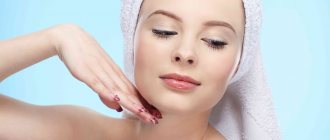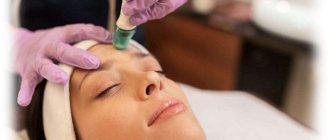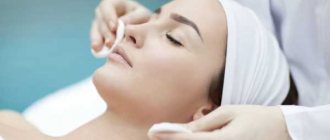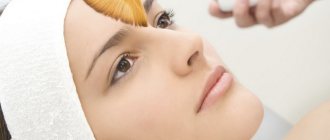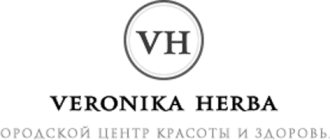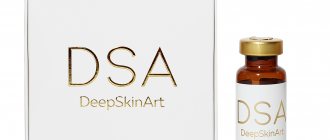After childbirth, women suffer from hormonal changes, lack of sleep, and weakened immunity, which negatively affects the condition of the skin. Many young mothers think about doing a deep facial cleansing, but they are stopped by the fear of harming the baby. Is peeling during breastfeeding really dangerous? What gentler means can replace it?
How does a woman’s body change during breastfeeding?
Let's start, as they say, “from the beginning.” During pregnancy, a woman's body undergoes natural changes associated with the intrauterine development of the fetus. After giving birth, a young mother is in a stressful state. All internal organs and systems work “for two”. After all, a newborn baby has not yet formed its own immunity and exists solely at the expense of maternal resources.
The first thing a woman in this condition pays attention to is the deterioration of her appearance. After all, the reflection in the mirror for the fair sex has always been, is and will be a source of special pride or disappointment - depending on what is seen. Naturally, this affects the psychological state (the same notorious postpartum depression).
What provokes such changes:
- Both pregnancy and lactation are accompanied by changes in hormonal levels. Acne, rashes, oily skin, pigmentation may appear;
- diet. Mom is forced to adhere to a certain diet, in which her body does not receive enough nutrients (vitamins, minerals) that are necessary for the normal functioning of an adult. As a result, regeneration processes slow down, local and general immunity is weakened;
- lactation. The child “sucks from the mother” the microelements it needs. And against the background of insufficient intake of them into the body with food, the condition of the skin worsens doubly;
- Nervous overstrain associated with a woman’s natural worries about the baby’s condition and lack of sleep cause psychological responses. This could be irritation, bad mood, depression of varying severity. Plus, even the smallest defects and shortcomings of the figure, appearance, and skin condition are noticed.
And the young mother begins to think about how to help herself return to her former state. First of all, get your face in order.
An option to solve the problem is peeling during breastfeeding. Experienced cosmetologists claim that this procedure is not only a whim of a nervous mother, but also an indispensable attribute of effective skin care. You just need to choose the right way to influence the skin, taking into account individual indicators.
Harm to nursing mothers
Chemical peeling is harmful during breastfeeding not only for the baby, but also for the nursing mother. If a baby can only suffer from deep exposure, then women’s skin can react negatively to a superficial procedure. The problem is associated with a serious transformation of a woman’s hormonal background during pregnancy and after childbirth.
Expert opinion - Anastasia Zaslavskaya Dermatologist and cosmetologist, playing it safe, do not recommend even superficial peeling to breastfeeding patients, since they cannot predict the reaction of the body, in which hormones are raging, to acid exposure.
When the skin comes into contact with acids, age spots and other unpleasant formations may appear, which are difficult to remove. Certain chemicals help get rid of excess pigmentation, but they cannot be used during the lactation period due to possible harm to the baby. Unfortunately, a woman has to walk around with ugly skin until the end of the breastfeeding period.
Why is it so harmful to peel during lactation?
Let us remember that peeling is a controlled, intentional damage to the skin of varying degrees of intensity, designed to activate the body’s internal reserves to renew the epidermis, get rid of defects and problem areas.
Peeling during lactation should, first of all, be safe for the baby. After all, he is defenseless against the outside world and exists only thanks to his mother’s “aura” (let’s call it that). But at the same time, it is necessary to take into account all of the above changes in the woman’s body.
Recently, peeling based on chemical compounds has become a popular cosmetic manipulation that can solve many different problems. It can be superficial (affecting only the upper ball of epidermal cells), middle (affecting deeper layers), deep (reaching the basal layer of the dermis).
Whether it is possible to do chemical peeling while breastfeeding depends on the type of procedure and the chosen chemical composition. Indeed, in all types of these procedures, among the contraindications and warnings, it is stated that they cannot be performed during pregnancy and breastfeeding. Let's look at the specifics.
- Medium and deep chemical peeling is a complete taboo for this period. Since the process uses aggressive components that enter the general bloodstream, they can harm the baby. After all, they will naturally end up in breast milk. If such “poisoning” for an adult body is not critical and often goes virtually unnoticed, then an imperfect child’s body is in serious danger.
- Superficial peeling is a gentle, soft procedure. The substances used are weak, in a concentration of no more than 10%. They act exclusively in the cells of the epidermis, without entering the general bloodstream. Therefore, they do not pose a threat to the baby. However, no cosmetologist can predict the reaction of the female body during this period.
- A woman may experience unpredictable allergic reactions against the background of unstable hormonal levels. Even those substances that were previously tolerated by the body absolutely normally.
Attention! There is no need to give up and wait for lactation to stop or reduce the time you feed your baby. There is an alternative, and there are also options for safe chemical peeling.
What means are used?
They resort to skin cleansing using special chemical compounds to improve complexion and remove various types of cosmetic defects. Chemicals eliminate old skin cells on its surface, and also penetrate into the next layers and force the body to activate the production of substances due to which the skin has good tone. This list includes:
- hyaluronic acid;
- collagen;
- elastin.
Superficial peeling using chemical agents is considered a harmless cosmetic procedure. To carry it out, various types of acids are used, including retinoic, glycolic, azelaic, phytic, and kojic.
Medium peeling requires a stronger acid – trichloroacetic acid. The burn affects the deeper layers of the skin and therefore the procedure is much more painful than superficial peeling. The healing period depends on how thin and sensitive the skin is, and on the regenerative potential of the body.
The deep chemical peel procedure requires the use of phenol. It is extremely painful and complete restoration of the skin takes some time, but the effectiveness of deep acid peeling is quite high.
Allowed and alternative methods
So, is it possible to do peeling while breastfeeding? The answer will be that it is possible and even necessary. We are considering salon procedures that are allowed for a nursing woman.
- Ultrasonic cleaning is positioned as a harmless, gentle manipulation. When exposed to ultrasound, dead skin cells are removed, comedones and sebaceous plugs are destroyed, metabolism is improved, and internal processes in epidermal tissues are stimulated. The procedure is usually painless, although it may cause mild discomfort in this condition. According to reviews from nursing mothers, it is not always effective.
- Glycolic peeling is recommended for women with oily skin, enlarged and clogged pores. Under the influence of glycolic acid, the microrelief is smoothed. The result becomes obvious a few days after the session.
- Almond peeling is safe for a nursing mother. Mandelic acid has an antioxidant, bactericidal, cleansing effect. Increases local immunity, eliminates rashes, increases the elasticity of epidermal fibers.
- Pyruvic peeling is a procedure that is ideal for this period. Many mothers complain of rashes, irritation, acne, and purulent pimples. The acidic component in the exfoliant has a therapeutic effect and helps to cope with the listed problems.
- Milk peeling is characterized by the highest safety. Lactic acid is already present in skin cells, which reduces the risk of developing allergic reactions to almost zero.
- Mechanical cleaning is a fairly effective procedure, but can be painful due to an increased pain sensitivity threshold.
As an alternative, you can use homemade exfoliating peeling based on sugar and sour cream, sea salt and olive oil, cream and coffee grounds.
Forced action or postpartum depression
The birth of a baby is the greatest joy for a mother, but clogged pores, the appearance of a large rash, and ulcers on the face can overshadow the moments of oblivion. What can provoke such troubles?
- A special hormonal background is the main culprit of skin imperfections. Pregnancy and lactation cause numerous changes in the body. Only from the rearrangement of hormones can a mother have serious problems with her skin: it becomes oily, the pores instantly become clogged, and a lot of inflamed pimples and ulcers appear;
- Strict diet - the diet of a nursing mother before the baby is introduced to complementary foods (about 4-5 months) is very limited. Food that is poor in vitamins and mineral components weakens the immune system, the protection of skin cells, and slows down their functioning;
- With milk, a woman’s body also leaves important microelements, so their insufficient supply from food for the skin is doubly “painful”;
- Constant lack of sleep and imperfect body shape after childbirth cause nervous tension and depression. The nursing mother begins to notice the slightest defects on the skin - and becomes even more upset.
Cosmetologists advise new mothers not to give up and not wait until breastfeeding is completed. Skin problems need to be dealt with without delay. Of course, nothing can be done about hormones, but issues with a lack of vitamins, mineral components and clogged pores can be solved by proper skin care and regular cleansing.
Facial peeling while breastfeeding is not a whim of a nervous mother, but part of mandatory skin care. The main thing is to organize it correctly so as not to harm the baby. There is no need to store skin problems until the end of lactation, because it will be very difficult to correct them later.
For most peels, breastfeeding is a contraindication; we will not consider them. We will focus on peelings that are safe for the baby:
- Ultrasonic skin cleansing is a gentle hardware peeling technique. Ultrasound has a gentle effect on the skin, destroys dead cells and sebaceous plugs, normalizes the functioning of the sebaceous glands and stimulates metabolism in cells. Peeling is painless, but slight discomfort may still be present. The peeling procedure is quite popular, but ineffective, according to reviews from nursing mothers;
- Glycolic peeling – has a delicate effect on the skin, eliminates the problem of excessive oiliness, cleanses pores and smoothes the facial texture. Peeling with glycolic acid is painless, and you will be pleased with the results a few days after the procedure.
- Almond peeling is a variant of acid peeling for the face, which can also be used during breastfeeding. Mandelic acid has high cleansing, bactericidal and antioxidant effects. Peeling with this acid narrows pores and increases cell immunity, affects problematic rashes and increases the elasticity of fibers. For a young mother, such peeling will be a real godsend;
- Pyruvic peeling – the procedure belongs to a series of acid peels. The procedure seems to have been created for nursing mothers. The fact is that many women during pregnancy and after childbirth complain of extensive rashes on their faces. Pyruvic acid has a high healing effect, so it is often used to treat problematic acne and acne;
- Milk peeling is a favorite cosmetic procedure for women during lactation. Lactic acid helps cope with dryness and age-related defects. It gently affects problem areas, cleanses the skin and pores of dirt particles that prevent it from breathing fully and absorbing beneficial components from skincare products. Some of the lactic acid is already contained in the cells of the epidermis, so the risk of an allergic reaction, complications and all kinds of troubles after peeling is minimized;
- Mechanical cleaning - the procedure can be used during breastfeeding. However, nursing mothers should take into account that peeling is harmless, but painful and requires long-term rehabilitation.
Cosmetologists say that acid peeling can be done during lactation, but only superficially and exclusively under the guidance of a professional in a salon. If the skin is deeply exposed, the acid can enter the bloodstream and be passed on to the baby's milk, so such peelings should be avoided.
What will cosmetologists say?
The advice of cosmetologists on peelings during breastfeeding is as follows:
- It is strictly not recommended to do acid peeling on your own;
- It should be taken into account that the peak of hormonal changes occurs 3-6 months after birth. As he approaches the age of one year, he approaches the prenatal indicator;
- before using any composition (including alternative means), it is necessary to do a tolerance test;
- strictly follow the post-departure rules recommended by a specialist;
- be prepared for the possibility of unpredictable consequences - pigmentation, the appearance of mycoses, exacerbation of herpes. If the procedure is performed by an experienced cosmetologist, he can foresee such complications. Conclusion - we trust only professionals.
And most importantly, there is no need to delay solving problems that have arisen and putting off solving them until after feeding. After all, there are cases when correcting the situation “later” will be very difficult, and sometimes almost impossible.
Exceptions that prove the rules
However, some exfoliation procedures are prescribed from time to time for young mothers, but only under the strict supervision of a dermatologist-cosmetologist, since for most peelings, breastfeeding is included in the list of contraindications (see Table):
| PEELING FOR HB | EFFECT |
| Glycolic |
|
| Almond |
|
| Pyrovinogradny |
|
| Lactic |
|
| Ultrasonic |
|
| Mechanical |
|
For those who still dare to undergo peeling while breastfeeding (BF), doctors advise waiting at least the first 6 months, because the culmination of endocrine changes occurs in the second quarter after childbirth. After 9-12 months, hormones completely calm down, gradually returning to prenatal levels.
Summary
To summarize: chemical peeling during lactation is not as harmful as it might seem at first glance. BUT... Only if the procedure is performed by an experienced cosmetologist, taking into account all individual characteristics.
Important! Be sure to tell your doctor that you are breastfeeding. It would not be amiss to mention how much time has passed since the birth. And feel free to answer questions, even if they seem a little inappropriate. Believe me, this is not idle curiosity, but a professional approach.
Treatment of stretch marks after childbirth
Stretch marks are the most common problem that reminds a woman of pregnancy for a long time, usually throughout her life. It has been noticed that young girls under 25 years of age are more susceptible to stretch marks compared to older mothers, and the likelihood of stretch marks appearing during the first pregnancy is much higher than during subsequent ones.
However, today there is a real opportunity to combat stretch marks. Procedures such as mesotherapy, biorevitalization, and thermolifting of the body should be carried out with fresh stretch marks to maximize the reduction of the skin between stretch marks and narrow the stretch marks. Since stretch marks are a type of atrophic scar, they can only be removed using a series of laser resurfacing procedures, the number of which depends primarily not on the length, but on the width of the stretch mark and the healing ability of the skin. Laser resurfacing is possible after the end of the lactation period and complete stabilization of weight.

